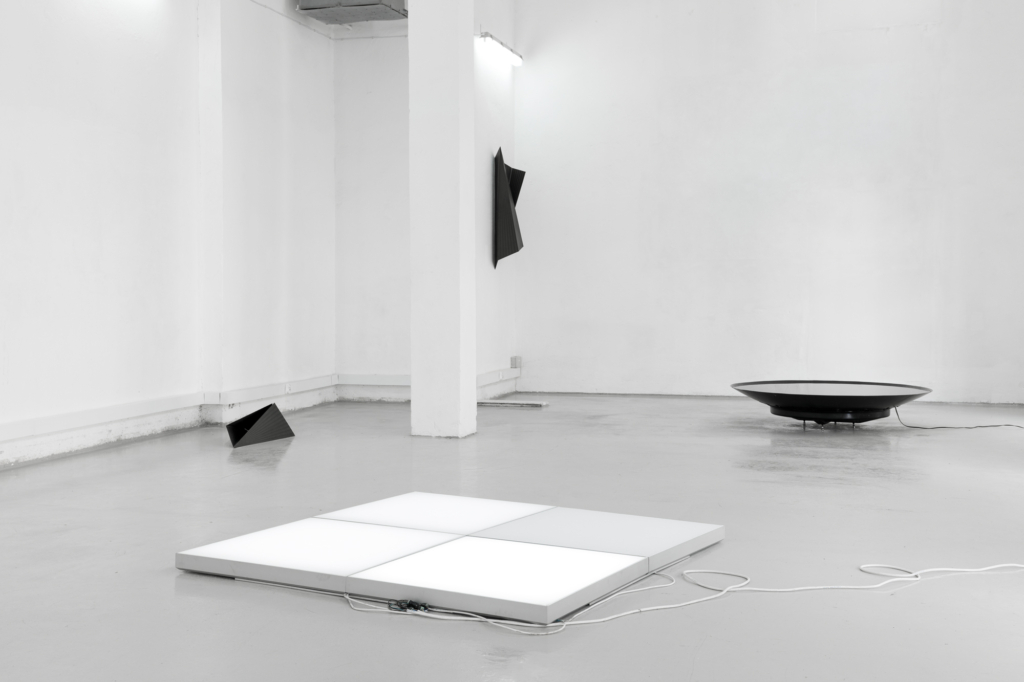

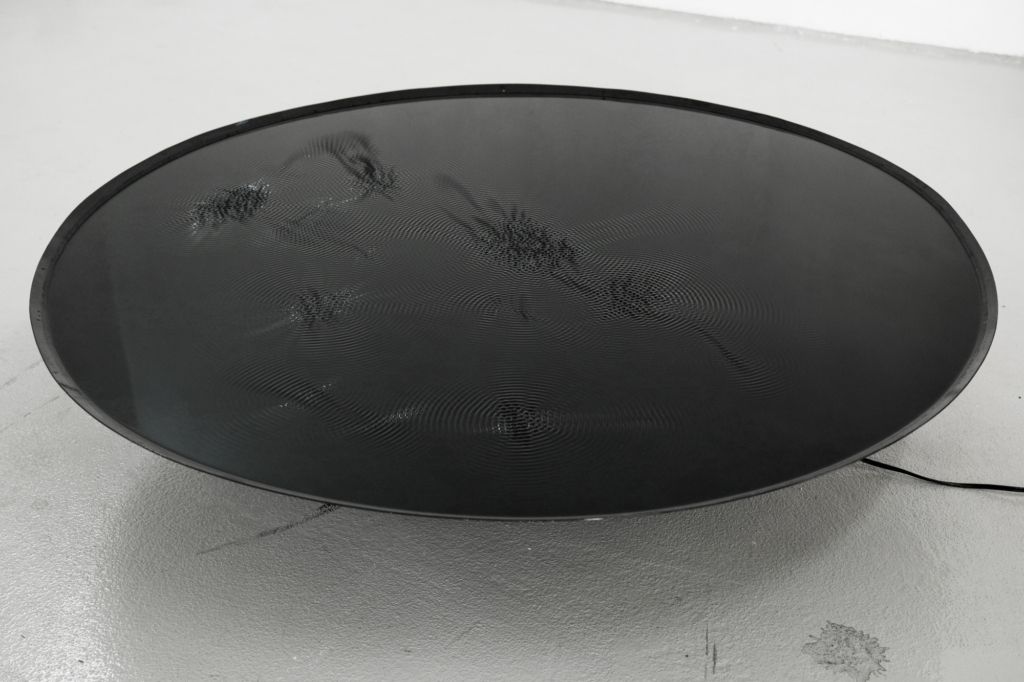


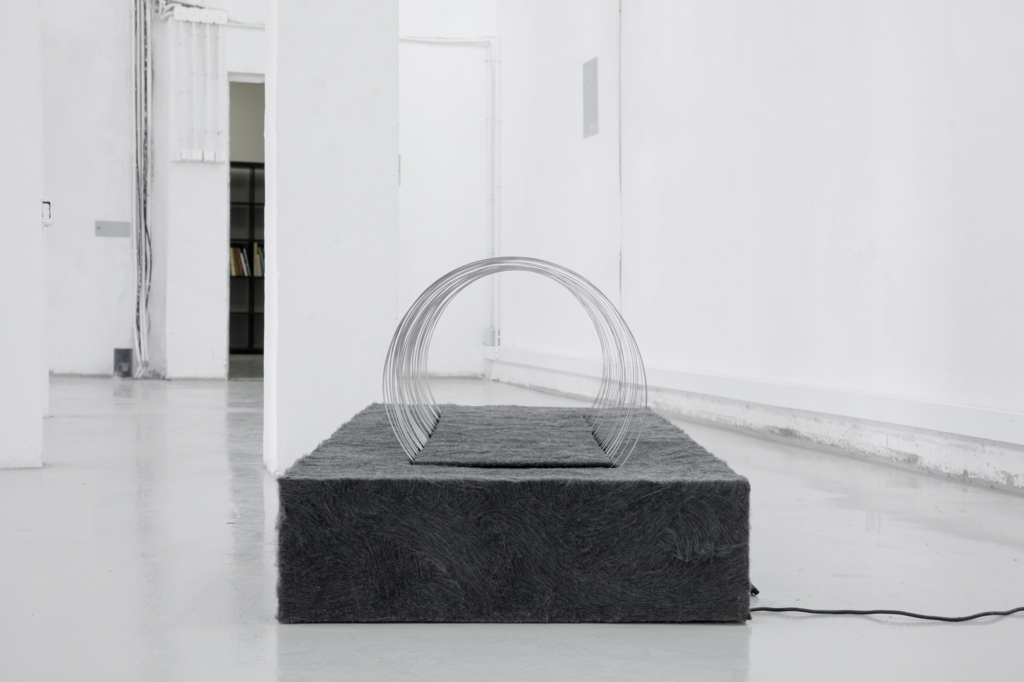
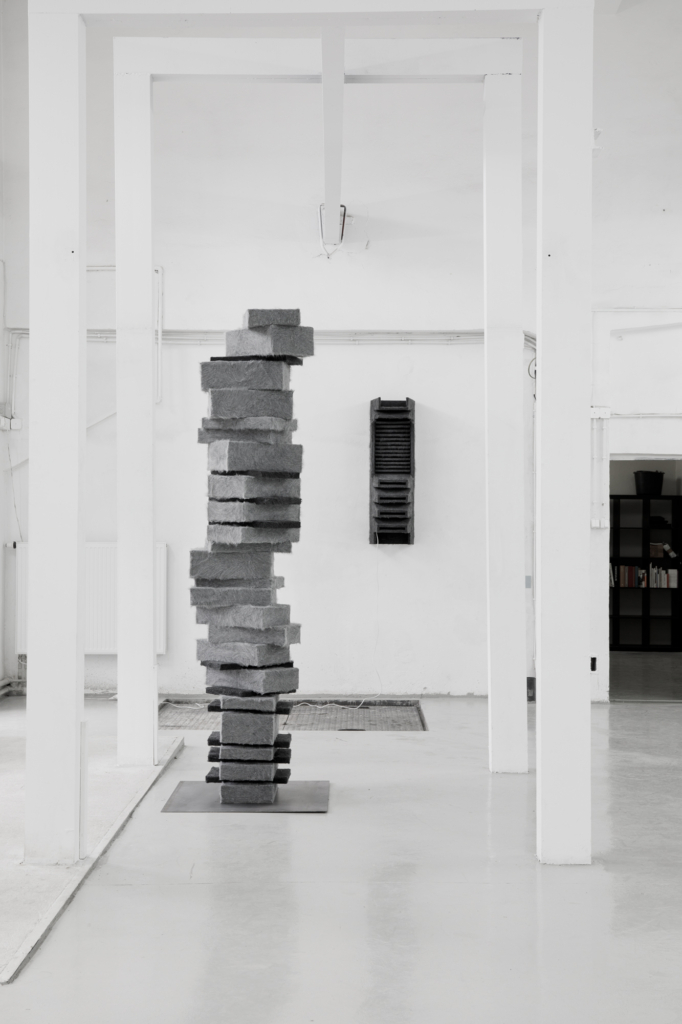
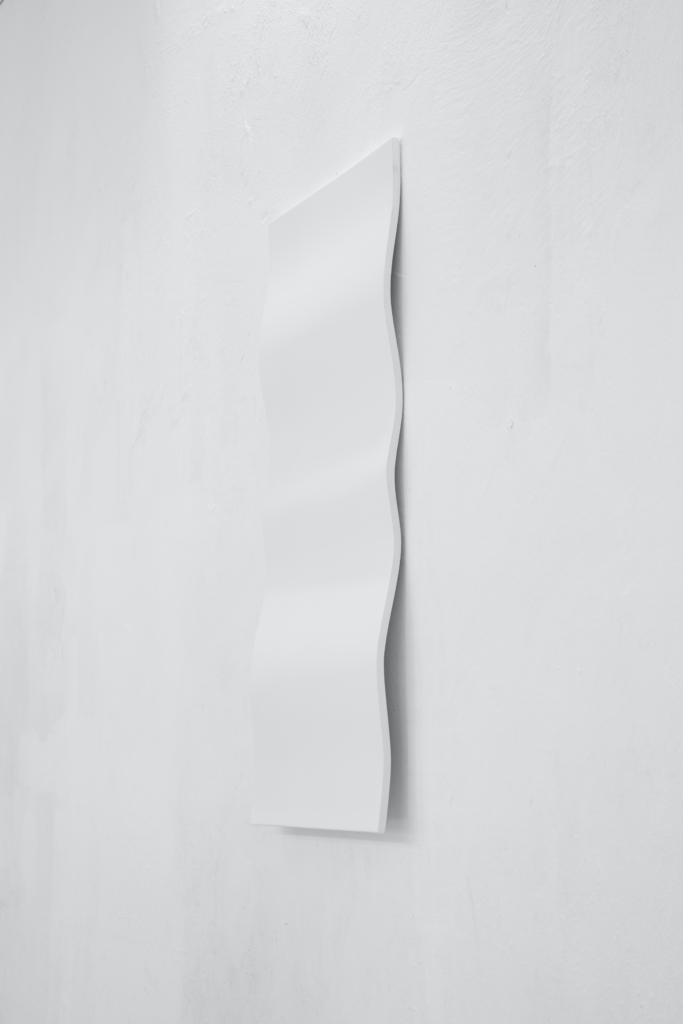
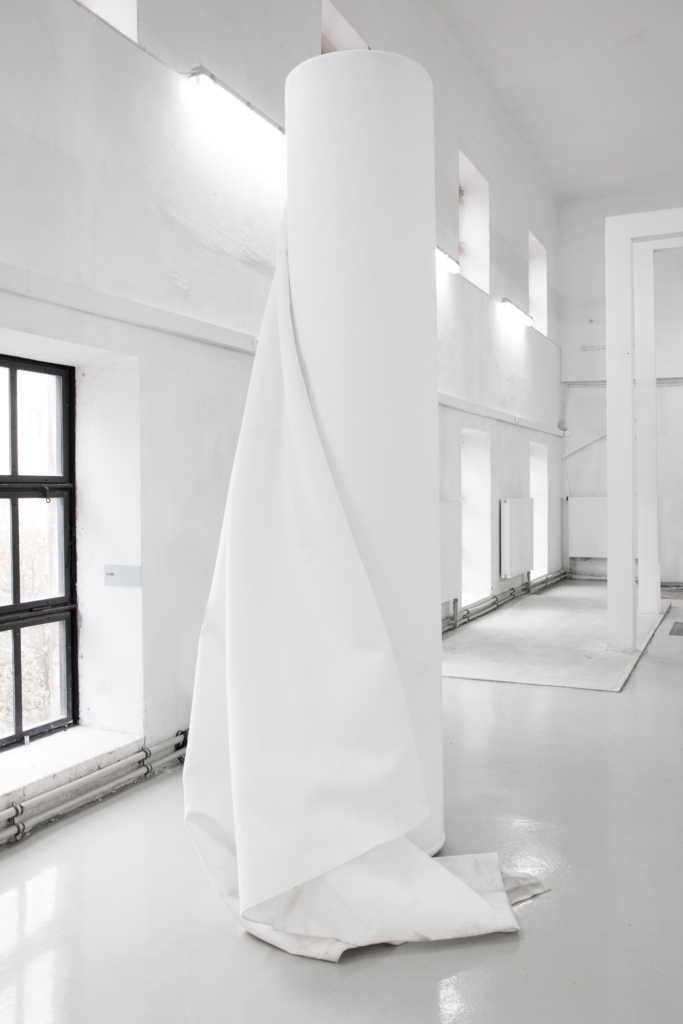

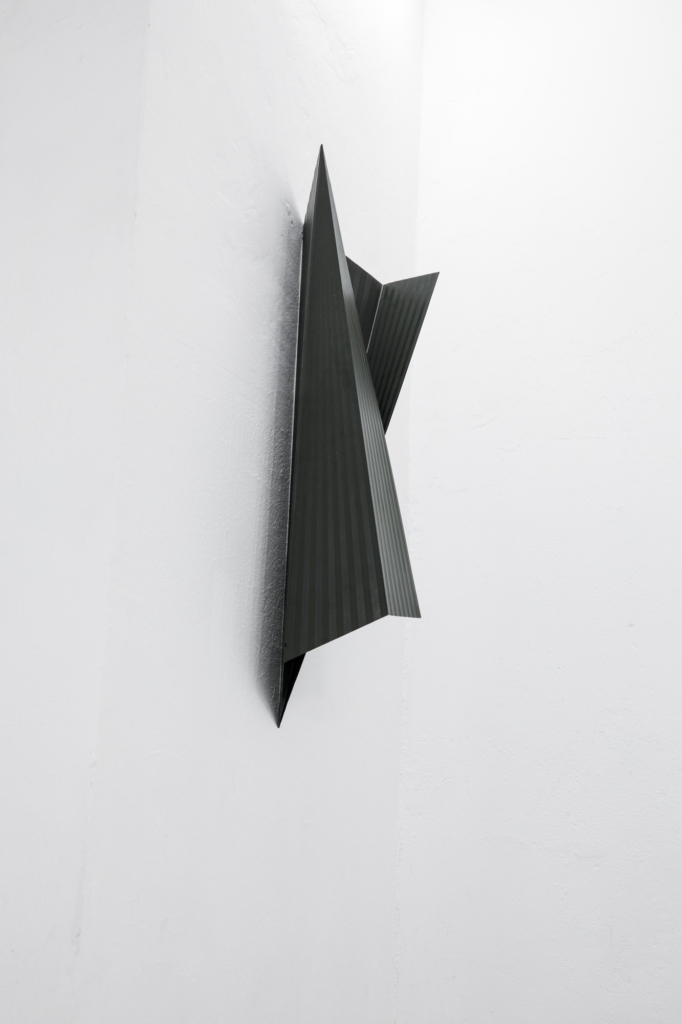


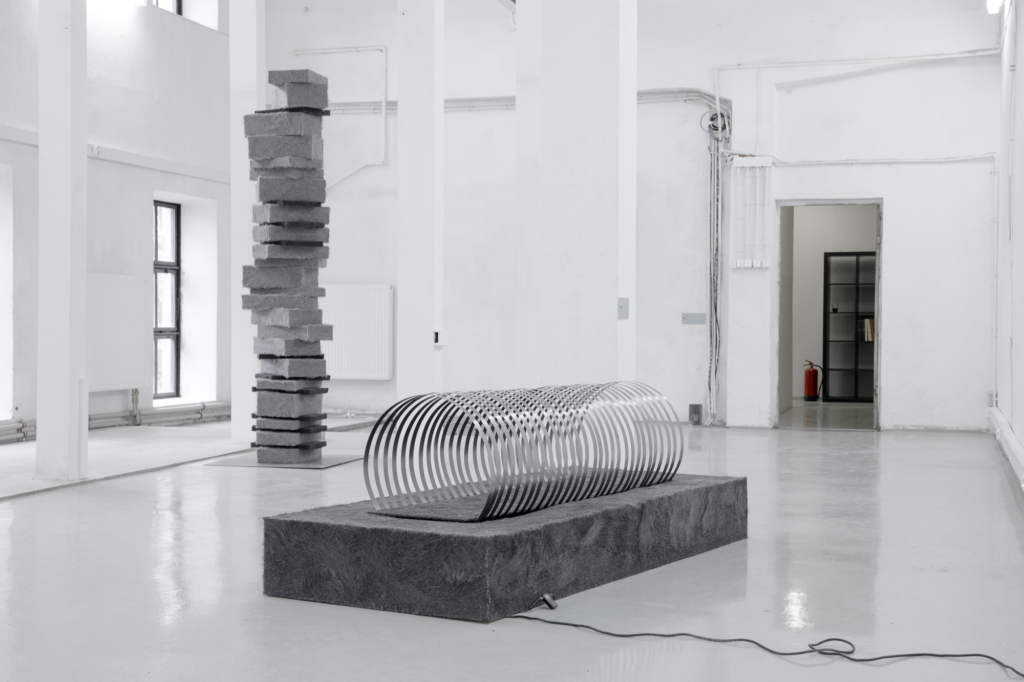
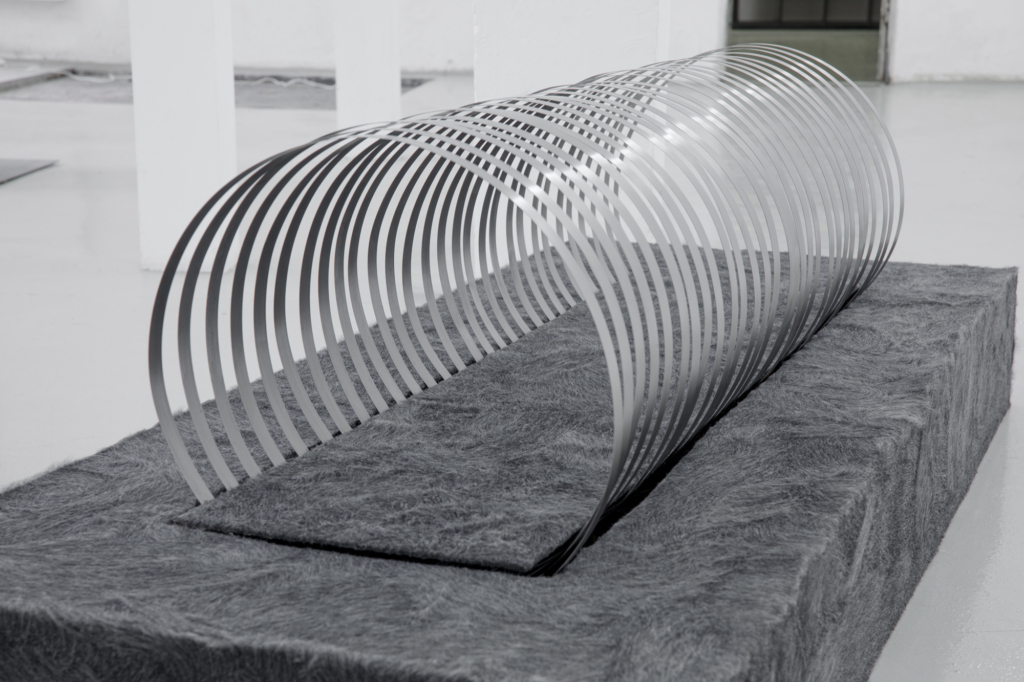
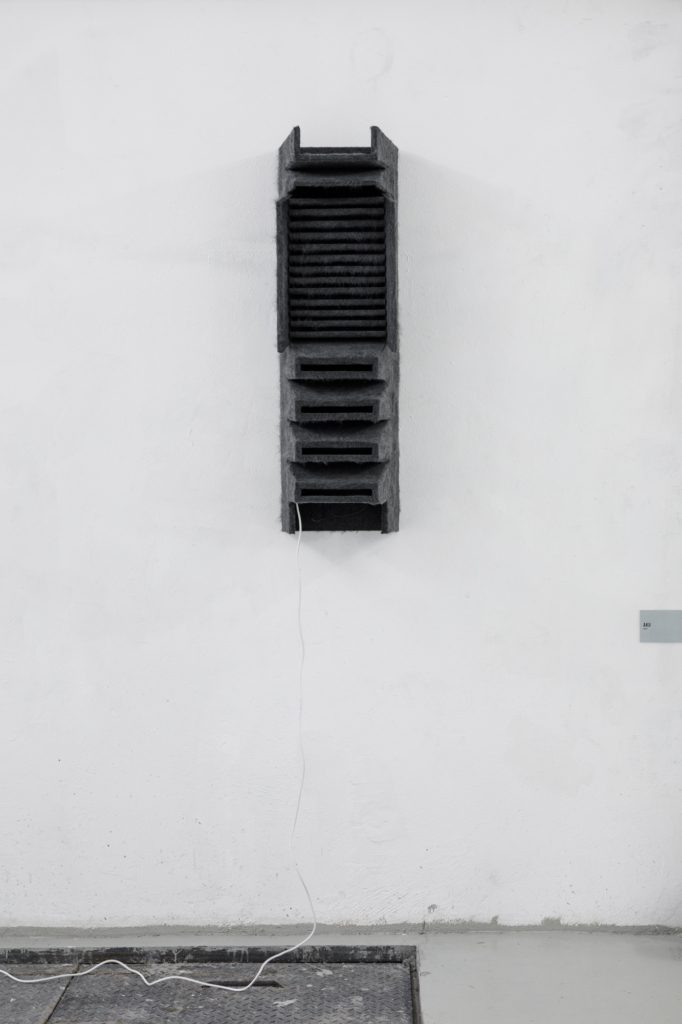
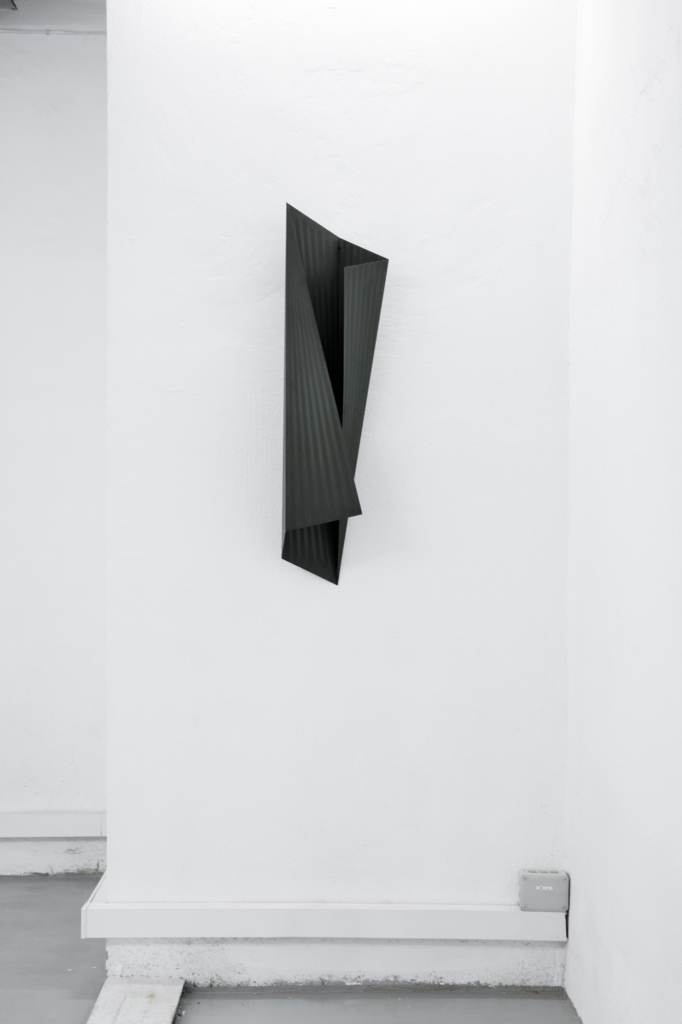
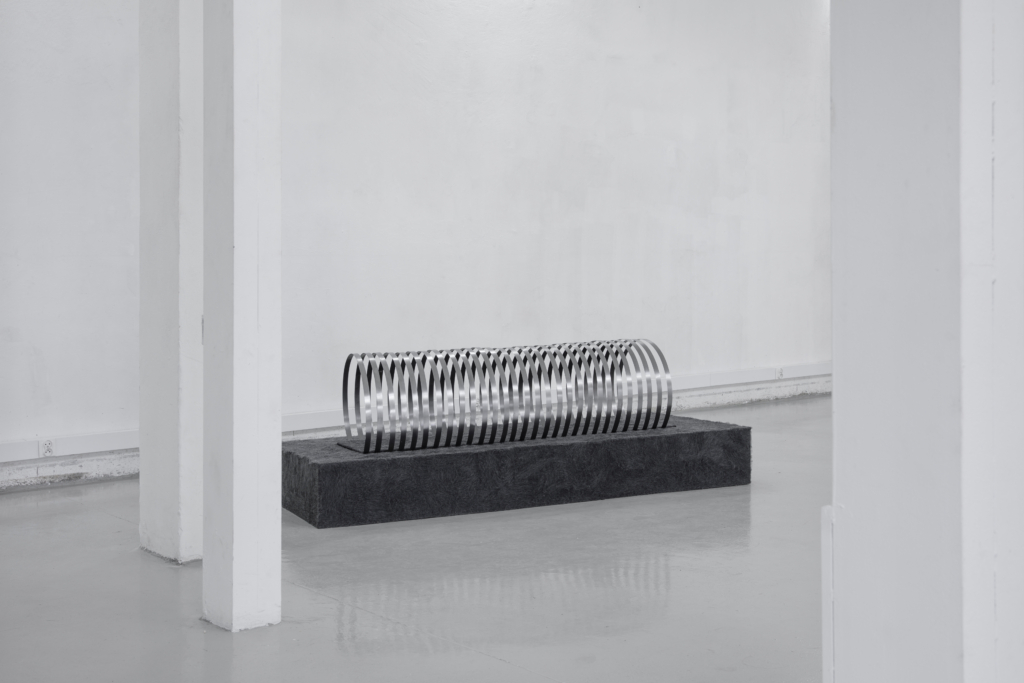

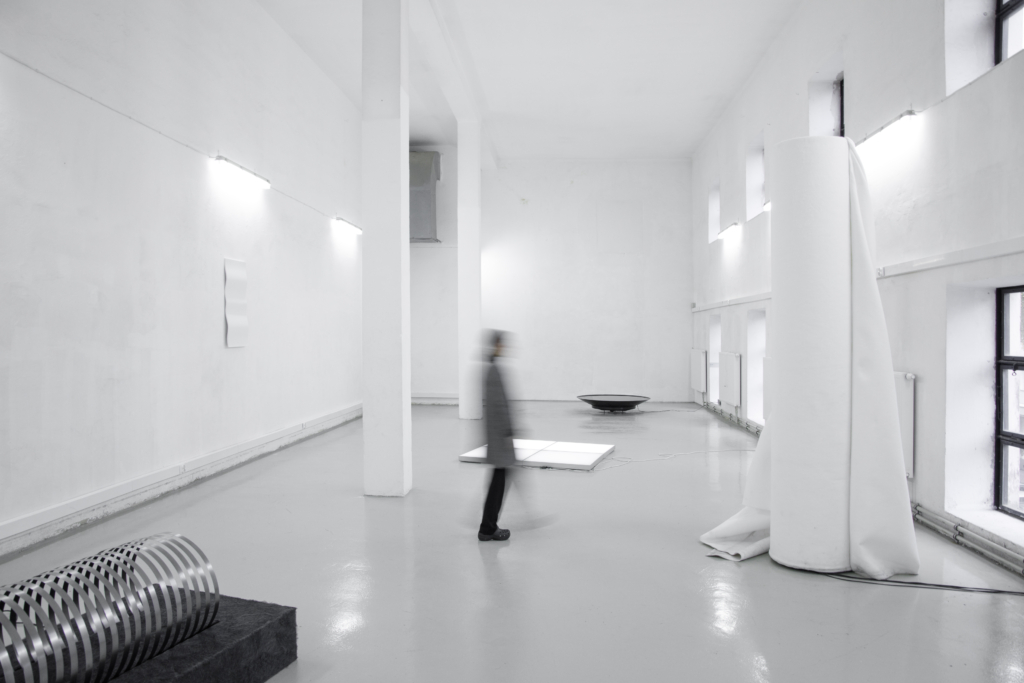
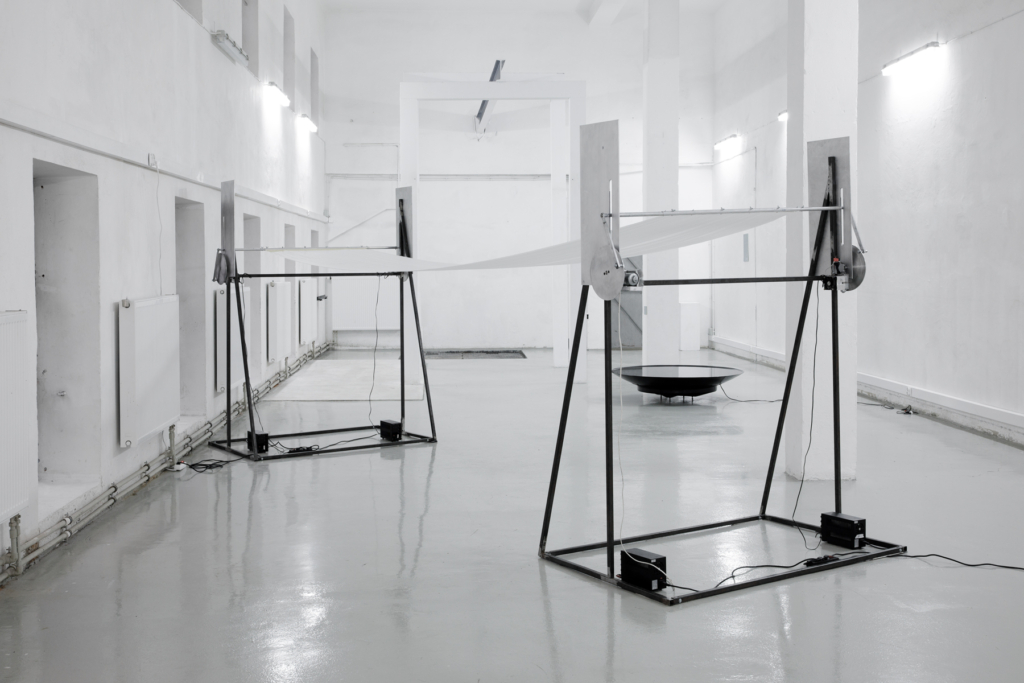
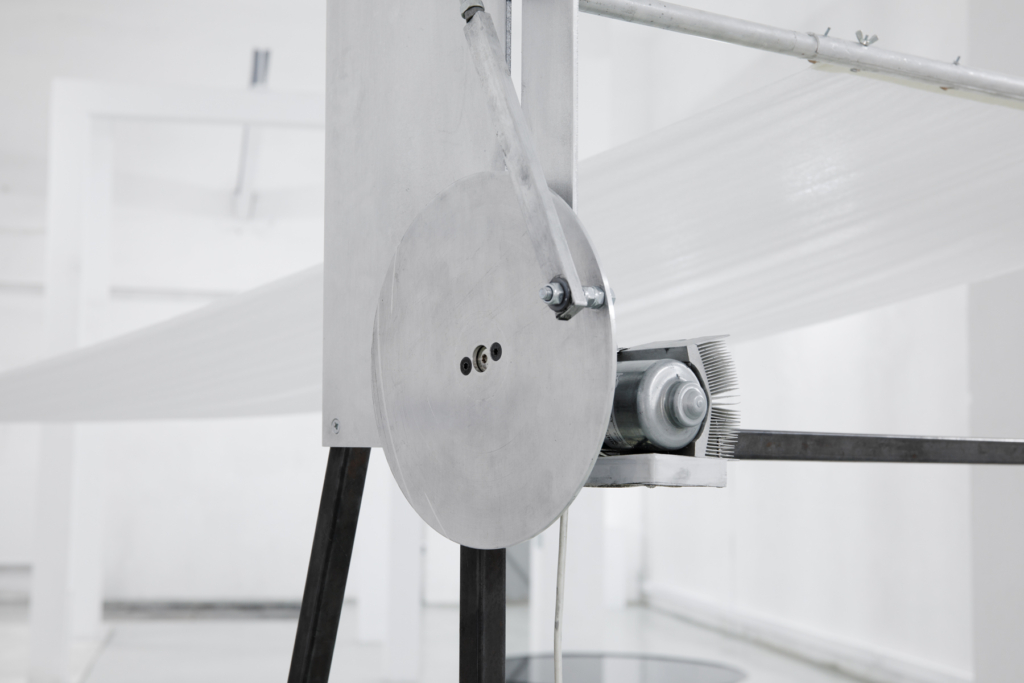

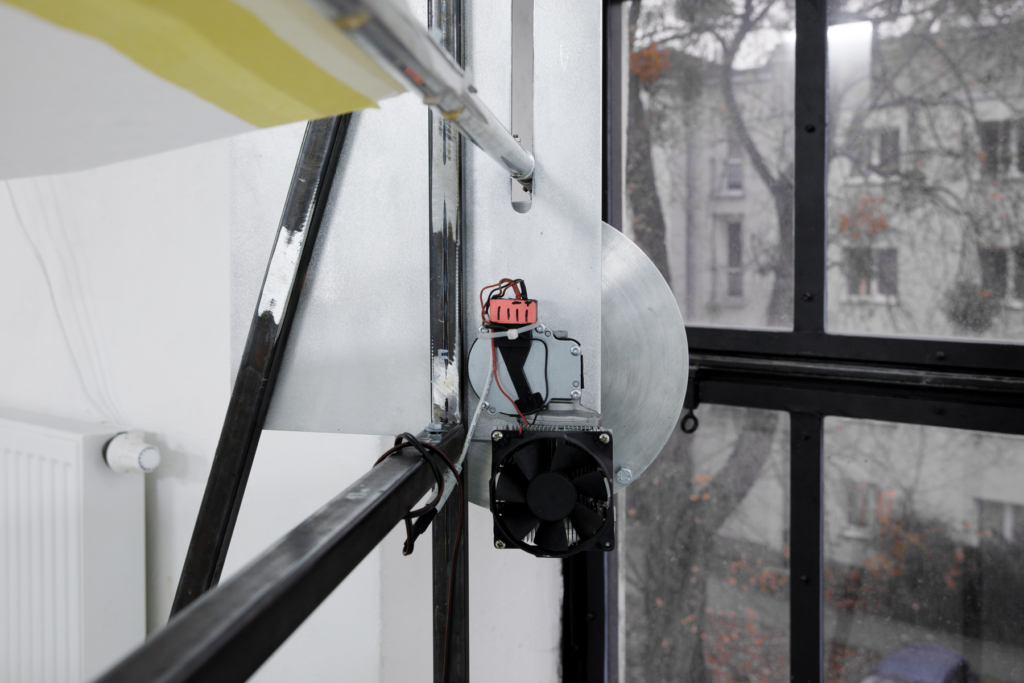

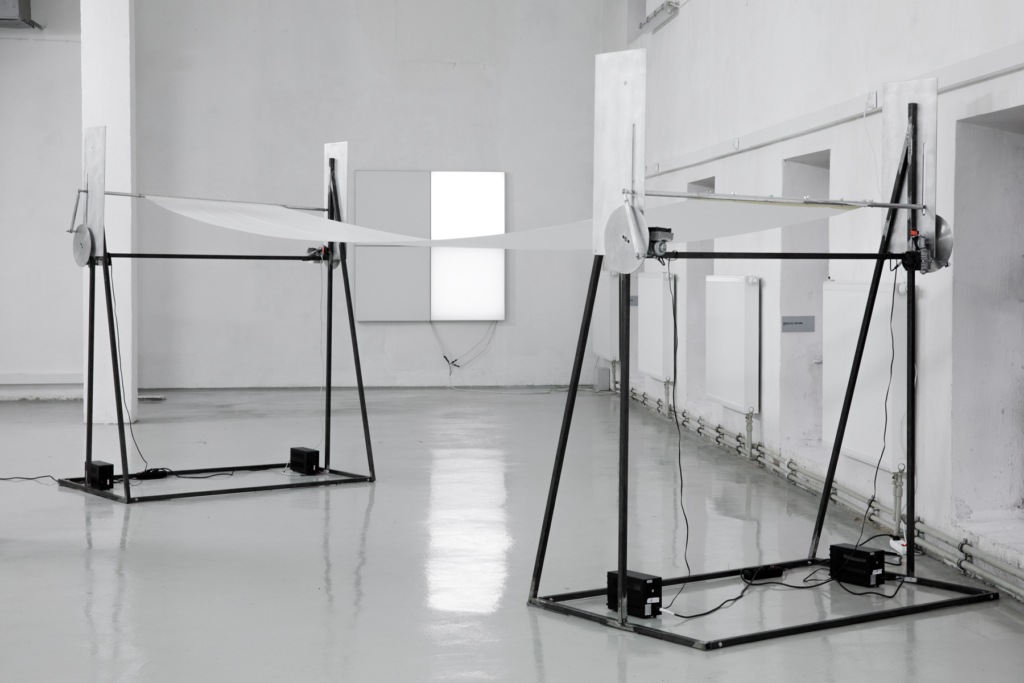
photos Michał Matejko
Crinkle Flutter Wrinkle Ripple
LELE Art Space, ul. Lelechowska 5, Warszawa
02/10 – 20/12/2022
curator: Paweł Kamiński
Na wystawę złożą premierowe i starsze prace z lat 2016 – 2022, wpisujące się w abstrakcyjny nurt nowego, silnie zmediatyzowanego formalizmu. Pierwszą, retrospektywną część pokazu zaplanowaliśmy na okres od 2 października do 15 listopada 2022. W części drugiej dodatkowo prezentować będziemy nową, rozbudowaną, powstałą latem 2022 pracę kinetyczną “Absolutely Nothing”. Partnerem wystawy jest Stowarzyszenie Autorów ZAiKS.
The exhibition will feature new and older works spanning over a period 2016-2022, falling under the category of the new, abstract and highly mediatized formalism. First, retrospective part of the show is planned from October the 2nd to November the 15th, 2022. In part two we will additionally present ”Absolutely Nothing”, a new, expanded, kinetic object created in the Summer of 2022. The exhibition is made possible in partnership with the ZAiKS Authors’ Association.
Lapidary critters
The famous watercolor and ink finished monotype by poet and printmaker William Blake, dated 1795, depicts the nude, exaggerated figure of a man somewhere at the bottom of the sea fiercely drawing sundry figures with a circular wheel. The athletic geometer is Newton.
He is supposed to epitomize the destructive power of reason and limited creation. Although Blake resisted almost all currents of the Enlightenment, the Newtonian theory of optics irritated him particularly. In an annotation to one of his engravings, Blake wrote: “Art Is the Tree of Life. Science is the Tree of Death.” For those maintaining that he experiences visions, speaks with the dead and penetrates unknown layers of experience Blake’s scientific method was harmful and sterile, and indeed – emerging with the birth of modern science, new images of the world were bound to lead to disputes, often of fundamental importance. Cartesian organization of the world composed of two separate substances, res cogitans and res extensa, begins to supplanted by a single principle of universal gravity. In Descartes’ view, motion was carried by whirlpools, similar to eddies on a river. In Newton’s mechanics, the same motion and free fall of bodies was explained by omnipresent gravity. This was not a difference of description of physical phenomena. The game was about extremely different conceptualizations of reality.
A good illustration of how deep the dispute went are episodes from the history of horticulture. When, in 1661, Minister Fouquet’s palace at the Vauxle- Vicomte, the French architect based the assumptions of the emerging garden on lines in line with the directions of thepropagation of light, he envisaged whirlpools presented as pools with fountains, and the whole design he determined by referring to the idea of res extensa, tensile substance. A few decades later, competing emerged competing English-style gardens, eager to refer to the principles of the new science. In “Epistle to Richard Boyle,” A. Pope criticized “artificial gardens” that “do not know that the most beautiful are the magnificences of the works of nature themselves.” Later examples can be multiplied, but the a career unique only to the reception of Einstein’s theory of relativity. After 1905, references to his groundbreaking research began to appear almost everywhere, starting with the one designed by Mendelsohn in 1920 of the Einstein Tower in Potsdam, ending with the works of Naum Gabo, El Lissitzky, Moholy-Nagy and many others*. More or less legitimate, the connection between science and art began long ago and is almost universal.
But how is a discovery made? Where do novelty, invention, breakthroughs in the development of knowledge come from? knowledge? Thinking about the phenomenon of discovery has been handled differently, and the question of its genesis has become one of the important problems of the 20th century philosophy of science. The first attempts were made as early as 1840. In the volumes Philosophy of Sciences, founded upon their history, William Whewell argued, that three conditions are necessary for making a discovery: A happy thought, its articulation and further development through testing. Whewell argued that only geniuses can count on a happy thought “the source of which we cannot trace; it is a stirring of the mind rising above the rules. It is impossible to give any maxims that inevitably lead to discovery or a recipe for happy thought.” According to Whewell, “the art of discovery,” in the sense of a skill that could be learned or that can be taught to others, does not exist. At the turn of the 20th century, a more radical view was expressed by the Viennese positivism, recognizing that only those discoveries that are based on repeatable laboratory observations, or derive from logic. The most stringent terms were proposed by Karl Popper. He rejected empirical research as a tool for discovering new knowledge, arguing that from a set of observations cannot be inferred from the correctness of general theorems. Popper’s proposed Popper’s method of demarcation was to separate the orderly, gradually developing sciences from other messier fields – but it soon turned out that in certain situations the requirement for of demarcation was also not met by logic and mathematics. These difficulties led other authors to the conviction that in the formal sciences, natural sciences, social sciences and humanities should apply additional rules, perhaps separate for each discipline. The idea as scattered and not finding a basis in actual scientific practice, however, was carried away, and although some aspects of demarcation in terms of practicality are still valid, but in research on the foundations of knowledge the concept has lost its relevance. Unlike Popper, the puzzle of the genesis of discovery was looked at by was looked at by historically oriented researchers. Born a century ago, Thomas S. Kuhn, to whom the modern language owes the expression “paradigm shift” with his work “The Structure of Revolutions of science” for decades shaped the image of science as an institution with its own strategy embedded in the social and cultural realities. This strategy is to absorb the scientific revolutions that erupt from time to time and completely changing the image of the world of scientific revolutions. The old “paradigm” is abandoned, and the the new one is quickly surrounded by modern and updated “normal science” – normal, i.e. widely accepted although fundamentally different from the previous one. Kuhn’s theory has made a worldwide career. It is still unclear whether science, and with it culture, “develops by passing through the
normal and revolutionary stages, the wave of which washes away previously recognized assumptions making room for a new, incommensurable paradigm “** (after all, why reject the old order as long as it is cognitively creative, well, unless “some men just want to watch the world burn “***), but “Structure” aptly described a certain regularity. Knowledge does not accumulate linearly, in its development it is possible to indicate periods of stagnation and phases of excesses. Forcibly, many, critical of Kuhn and Popper’s approaches, from the extravagance of methodological anarchist Paul Feyerabend (“anything goes!”) to the purism of the scientists themselves recognizing only hard, laboratory-obtained data. The Stanford Encyclopedia, revered for its humor, described this state of affairs as follows: “a discovery is the the result of successful research. The objects of discovery may be things, events, causes and properties, as well as theories and their characteristics. The debates about discovery have been intricate and complex, as the the term itself has been used in many ways, both in the narrowest sense as “discovery” which refers to the supposed “eureka moment” accompanying the acquisition of a new insight, and in the the broadest sense in which it is synonymous with “a successful endeavor” tout
court.”
Among other things, Dabrowski says of his works: “selecting and focusing on the most important subjects for me, I look for simplicity. I am interested in basic phenomena occurring in nature like the flow of energy and incessant processuality, everything that influences the constant change. Thinking about physical concepts forms the basis of my understanding of the environment. I look for meanings that emerge contemplatively, naturally, over time (…).”
Dabrowski’s recurring analysis of “constant movement and evolutionarily determined change on the one hand paraphrases the behavior of a living organism” – as critics have written about the artist – “on the on the other hand, has the potential to create space. A space that connects.” The first, retrospective part of the exhibition takes place from October 2 to November 15, 2022, with a selection of objects from the years 2016 – 2022 constitute a kind of overview of constant themes in Dabrowski’s work. These include experiments with sound and light propagation, applications of partly repetitive and partly stochastic motion and micromechanics, as well as observation of wave phenomena and transformations of the of the geometry of space, both of the object itself and of the surrounding, found conditions of the architectural conditions. The second part of the exhibition from October 16, 2022 will present the the premiere kinetic-sound work, created in the summer of 2022 and never shown in Warsaw before.
The object, entitled “Absolutely Nothing,” is one of the first, after “Caterpillar” from 2018, such an elaborate realization by Dabrowski. The installation consists of two steel pillars spaced several meters apart, steel pillars between which, with the help of specially programmed, operating independently of each other, moves a paper membrane set in cyclic motion movement of a paper membrane. The wave-like motion follows the principles of mathematical modeling mathematical modeling, but above all it has a striking performative, visual and sonic quality, which resembles a carefully composed, edited and rendered video rather than a set in a physical space, a tangible object. Dabrowski most often works on installations in longer cycles of several years – this is the case with “Generators,” “Black” and “Mirrors,” but the same is also true of other works in the artist’s extensive catalog, which, due to the limited size of the gallery room, could not be included in the exhibition presented at Lele Art Space. Dabrowski uses concise criteria. Some of them sound almost like quotations from selected theses of Kuhn, Lakatos, or Popper. The preparation of the work and its final result must be: logically and conceptually coherent; as as simple as possible; contain only those concepts that are actually necessary; and should provide an possibility to create further detailed proposals within the cycle. The most general turns out to be method of operation consisting of research and testing, but there is more. A paradigm is distinguished from dogma that it is not given once and for all, secondly, Dabrowski’s cycles do not develop sequentially and gradually, nor do they emerge revolutionarily.
So how?
Attempts to identify a third and even fourth and fifth way in thinking about discovery were undertaken almost immediately, as major publications in the philosophy of science appeared. The author of the notion of “tacit knowledge” Michael Polanyi tried to explain how remonition helps to select the places where future discoveries can be expected, and how intuition helps bring one closer to identifying and solving new problems. Implicit knowledge, unlike formal knowledge or already codified, is obviously not a trivial abracadabra. Instead, according to Polanyi, it is a state that is difficult to express or extract, and even more difficult to communicate to others. The knowledge that Detroit is located in America is an element of explicit knowledge – and as such can be written down and later understood by the recipient. The ability to speak a language, play a musical instrument or kneading dough, however, requires, Polanyi argues, a different kind of knowledge that is not fully legible even to experienced practitioners, and is therefore difficult or impossible to transfer to others, even if adequately prepared to do so. It looks as if new realizations similar to those of “Crinkle Flutter Wrinkle Ripple” were created by sensing where they might still hide problems to be solved, but also in some sense in line with ongoing since the end of the last century century directions in discovery research, which indicate that cognition is based on a kind of modeling. This approach assumes that reasoning, including problem solving, takes place occurs through comprehensive, “multimedia” modeling with the mind. It is aided by everything: color, sound, senses, computation, memory, emotion and error. Modeling, like “tacit knowledge”, precede the methodological apparatus. In model-based thinking, the mind creates a representation of a real or imagined situation, and later freely processes it. Recent research focuses on the fundamentals of each act of creating new knowledge, while the analysis of discovery combining modeling, cognitive science and neuroscience, taking into account the social conditions involved in the generation of new ideas, thus becomes part of a broader enterprise involving the study of creative thinking in general. Some of the explorations seek to describe moments common to all creative processes. Others aim to identify characteristics that distinguish only scientific creativity – as opposed to its other forms, such as creative artistic, creative invention or technological proficiency. It is clear that creative acts are not simple production of knowledge, but, as Nelson Goodmann noted, “the connections here are deeper and the differences different than is usually supposed. The difference between art and science is not the juxtaposition of fact and affect, intuition and inference, impression and reflection, synthesis and analysis, concrete and abstract, mediation and directness, but rather the stronger dominance of certain characteristics within one discipline to a greater extent than the other, although the set of characteristics itself is similar (…) Declarations of unity, whether they are to apply to the sciences alone, the arts alone, or the arts and sciences combined, and so direct attention to the differences. “**** Polanyi who was neither exactly a scientist, philosopher nor much less an artist, was criticized for the solipsism attributed to him. He may have been wrong, but he effectively applied the idea of “tacit knowledge” to understanding Menon’s old paradox: “to seek solution to a problem is absurd because either you know what you are looking for and then there is no problem, or you don’t know what you’re looking for, and then you can’t expect to find anything.” Interestingly, the proposals decades later consider discoveries to be the result of intimate processes preceding the actual research, the effort put into developing the idea and the workshop aspects. Maybe simply, as in the days of James Maxwell, Caroline Herschel, Rosalind Franklin, Edwin Hubble and Vera Rubin, the best method for new descriptions of reality is to build at least intuitive models and testing them experimentally – for example, in conditions such as a publicly available exhibition.
- *Bartosz Brożek, “The Limits of Interpretation,” Copernicus Center Press, 2014.
** Thomas S. Kuhn, “The Structure of Scientific Revolutions,” afterword by H. Ostromęcka, Aletheia, 2001.
*** Alfred Pennyworth, “The Dark Knight,” Warner Bros, 2008
**** Nelson Goodman, “Languages of Art,” Hackett Publishing, 1976
Paweł Kamiński
CRINKLE, FLUTTER, WRINKLE, RIPPLE
.